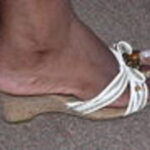Everyone gets them at one point or another, those annoying nodules of hardened flesh: calluses, corns, and bunions. All these are the results of excessive rubbing/pressure on the affected area, where the body builds up the flesh in an attempt to protect itself. While calluses start out small and rough and nothing more than a nuisance, if left untreated they can become large and painful. After a year or two of rubbing, calluses can become so cracked and damaged that it requires surgery to remove them. If treated soon enough, it can be very simple to remove a callus.
To remove a callus, fill a bucket/tub with the hottest water you can stand and soak the affected limb in it; if the water is extremely hot, you should only have to soak for about 5 minutes. Once the calluses have turned completely white and soft, use a blunt object, such as the dull side of a dinner knife, to scrape at the white calluses. DO NOT use a sharp object, cut, or saw at the callus. You will destroy your skin, cause scarring, and likely cause the callus to return larger than it previously was. After you have scraped off the majority of the dead skin, use a pumice stone to gently sand the area.
After you have scraped the callus until the white is gone, wash the area gently with soap and dry. After the area has thoroughly dried, you will know whether or not the entire callus has been removed. You may have to repeat the removal process two or more times before the calluses are gone.
After you have removed the entire callus, the skin is still likely to feel rough, though not raised. There are several ways to soften the skin. One method is to regularly steam the area. Unless you have the proper equipment, this method will not be effective, and if you do have the right equipment, the process can still be a lengthy one.
Another method is to purchase pedicure lotion from a spa, or extra-moisturizing lotion. You may have to try several lotions before finding an effective one. After you have selected a lotion, apply it liberally to your feet, if that is the affected area, leaving a generous coat. With the lotion on your feet, wear thick cotton socks. Then wear slippers over your socks; the goal is to keep your feet warm/hot, which will open the pores and aid the lotion in moisturizing your feet. Do this as often as necessary; results are usually seen after a time or two.
If your hand is the affected area, you can repeat the same process as you would for you feet, apply lotion to your hand, then wearing a cotton glove. You can then place your gloved hand into a winter glove meant for working in snow. This will make your hands hot, aiding the lotion. Repeat as often as necessary.
This is my method of removing calluses; I have always had good results with this method. Understand that this removal processes will not work for corns, which are pitted downwards into the skin. These usually require the assistance of a doctor. Also, if your callus is to far progressed, this method alone will not be enough. If the callus is painful, cracked, scabbed, or infected, you must see a podiatrist; these conditions can not be treated at home, and can be lead to serious infections, including gangrene.



